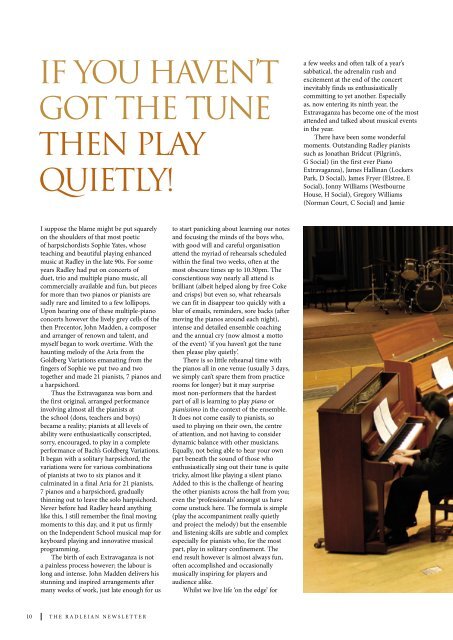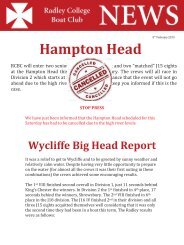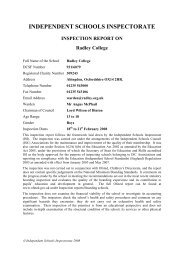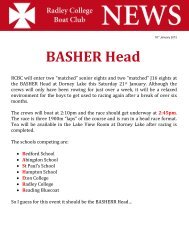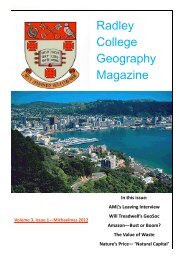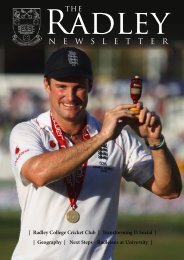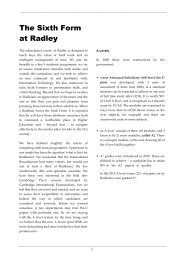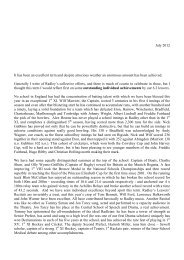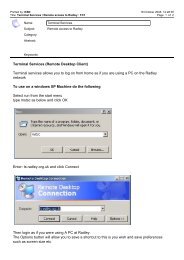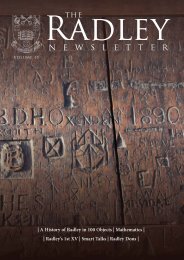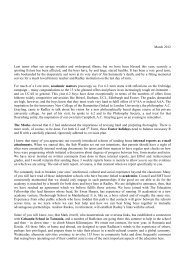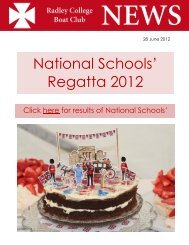N E W S L E T T E R - Radley College
N E W S L E T T E R - Radley College
N E W S L E T T E R - Radley College
You also want an ePaper? Increase the reach of your titles
YUMPU automatically turns print PDFs into web optimized ePapers that Google loves.
If you haven’t<br />
got the tune<br />
then PLAY<br />
QUIETLY!<br />
a few weeks and often talk of a year’s<br />
sabbatical, the adrenalin rush and<br />
excitement at the end of the concert<br />
inevitably finds us enthusiastically<br />
committing to yet another. Especially<br />
as, now entering its ninth year, the<br />
Extravaganza has become one of the most<br />
attended and talked about musical events<br />
in the year.<br />
There have been some wonderful<br />
moments. Outstanding <strong>Radley</strong> pianists<br />
such as Jonathan Bridcut (Pilgrim’s,<br />
G Social) (in the first ever Piano<br />
Extravaganza), James Hallinan (Lockers<br />
Park, D Social), James Fryer (Elstree, E<br />
Social), Jonny Williams (Westbourne<br />
House, H Social), Gregory Williams<br />
(Norman Court, C Social) and Jamie<br />
I suppose the blame might be put squarely<br />
on the shoulders of that most poetic<br />
of harpsichordists Sophie Yates, whose<br />
teaching and beautiful playing enhanced<br />
music at <strong>Radley</strong> in the late 90s. For some<br />
years <strong>Radley</strong> had put on concerts of<br />
duet, trio and multiple piano music, all<br />
commercially available and fun, but pieces<br />
for more than two pianos or pianists are<br />
sadly rare and limited to a few lollipops.<br />
Upon hearing one of these multiple-piano<br />
concerts however the lively grey cells of the<br />
then Precentor, John Madden, a composer<br />
and arranger of renown and talent, and<br />
myself began to work overtime. With the<br />
haunting melody of the Aria from the<br />
Goldberg Variations emanating from the<br />
fingers of Sophie we put two and two<br />
together and made 21 pianists, 7 pianos and<br />
a harpsichord.<br />
Thus the Extravaganza was born and<br />
the first original, arranged performance<br />
involving almost all the pianists at<br />
the school (dons, teachers and boys)<br />
became a reality; pianists at all levels of<br />
ability were enthusiastically conscripted,<br />
sorry, encouraged, to play in a complete<br />
performance of Bach’s Goldberg Variations.<br />
It began with a solitary harpsichord, the<br />
variations were for various combinations<br />
of pianists at two to six pianos and it<br />
culminated in a final Aria for 21 pianists,<br />
7 pianos and a harpsichord, gradually<br />
thinning out to leave the solo harpsichord.<br />
Never before had <strong>Radley</strong> heard anything<br />
like this, I still remember the final moving<br />
moments to this day, and it put us firmly<br />
on the Independent School musical map for<br />
keyboard playing and innovative musical<br />
programming.<br />
The birth of each Extravaganza is not<br />
a painless process however; the labour is<br />
long and intense. John Madden delivers his<br />
stunning and inspired arrangements after<br />
many weeks of work, just late enough for us<br />
to start panicking about learning our notes<br />
and focusing the minds of the boys who,<br />
with good will and careful organisation<br />
attend the myriad of rehearsals scheduled<br />
within the final two weeks, often at the<br />
most obscure times up to 10.30pm. The<br />
conscientious way nearly all attend is<br />
brilliant (albeit helped along by free Coke<br />
and crisps) but even so, what rehearsals<br />
we can fit in disappear too quickly with a<br />
blur of emails, reminders, sore backs (after<br />
moving the pianos around each night),<br />
intense and detailed ensemble coaching<br />
and the annual cry (now almost a motto<br />
of the event) ‘if you haven’t got the tune<br />
then please play quietly’.<br />
There is so little rehearsal time with<br />
the pianos all in one venue (usually 3 days,<br />
we simply can’t spare them from practice<br />
rooms for longer) but it may surprise<br />
most non-performers that the hardest<br />
part of all is learning to play piano or<br />
pianissimo in the context of the ensemble.<br />
It does not come easily to pianists, so<br />
used to playing on their own, the centre<br />
of attention, and not having to consider<br />
dynamic balance with other musicians.<br />
Equally, not being able to hear your own<br />
part beneath the sound of those who<br />
enthusiastically sing out their tune is quite<br />
tricky, almost like playing a silent piano.<br />
Added to this is the challenge of hearing<br />
the other pianists across the hall from you;<br />
even the ‘professionals’ amongst us have<br />
come unstuck here. The formula is simple<br />
(play the accompaniment really quietly<br />
and project the melody) but the ensemble<br />
and listening skills are subtle and complex<br />
especially for pianists who, for the most<br />
part, play in solitary confinement. The<br />
end result however is almost always fun,<br />
often accomplished and occasionally<br />
musically inspiring for players and<br />
audience alike.<br />
Whilst we live life ‘on the edge’ for<br />
10 THE RADLEIAN NEWSLETTER


